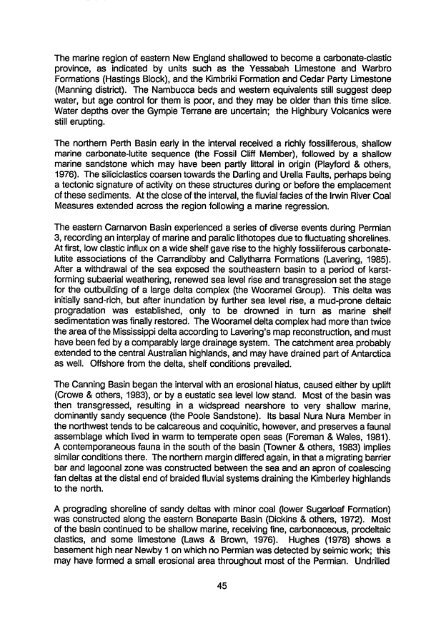II II II II II - Geoscience Australia
II II II II II - Geoscience Australia
II II II II II - Geoscience Australia
Create successful ePaper yourself
Turn your PDF publications into a flip-book with our unique Google optimized e-Paper software.
The marine region of eastern New England shallowed to become a carbonate-clastic<br />
province, as indicated by units such as the Yessabah Limestone and Warbro<br />
Formations (Hastings Block), and the Kimbriki Formation and Cedar Party Limestone<br />
(Manning district). The Nambucca beds and western equivalents still suggest deep<br />
water, but age control for them is poor, and they may be older than this time slice.<br />
Water depths over the Gympie Terrane are uncertain; the Highbury Volcanics were<br />
still erupting.<br />
The northern Perth Basin early in the interval received a richly fossiliferous, shallow<br />
marine carbonate-lutite sequence (the Fossil Cliff Member), followed by a shallow<br />
marine sandstone which may have been partly littoral in origin (Playford & others,<br />
1976). The siliciclastics coarsen towards the Darling and Urella Faults, perhaps being<br />
a tectonic signature of activity on these structures during or before the emplacement<br />
of these sediments. At the close of the interval, the fluvial facies of the Irwin River Coal<br />
Measures extended across the region following a marine regression.<br />
The eastern Carnarvon Basin experienced a series of diverse events during Permian<br />
3, recording an interplay of marine and paralic lithotopes due to fluctuating shorelines.<br />
At first, low clastic influx on a wide shelf gave rise to the highly fossiliferous carbonatelutite<br />
associations of the Carrandibby and Callytharra Formations (Layering, 1985).<br />
After a withdrawal of the sea exposed the southeastern basin to a period of karstforming<br />
subaerial weathering, renewed sea level rise and transgression set the stage<br />
for the outbuilding of a large delta complex (the Wooramel Group). This delta was<br />
initially sand-rich, but after inundation by further sea level rise, a mud-prone deltaic<br />
progradation was established, only to be drowned in turn as marine shelf<br />
sedimentation was finally restored. The Wooramel delta complex had more than twice<br />
the area of the Mississippi delta according to Lavering's map reconstruction, and must<br />
have been fed by a comparably large drainage system. The catchment area probably<br />
extended to the central <strong>Australia</strong>n highlands, and may have drained part of Antarctica<br />
as well. Offshore from the delta, shelf conditions prevailed.<br />
The Canning Basin began the interval with an erosional hiatus, caused either by uplift<br />
(Crowe & others, 1983), or by a eustatic sea level low stand. Most of the basin was<br />
then transgressed, resulting in a widspread nearshore to very shallow marine,<br />
dominantly sandy sequence (the Poole Sandstone). Its basal Nura Nura Member in<br />
the northwest tends to be calcareous and coquinitic, however, and preserves a faunal<br />
assemblage which lived in warm to temperate open seas (Foreman & Wales, 1981).<br />
A contemporaneous fauna in the south of the basin (Towner & others, 1983) implies<br />
similar conditions there. The northern margin differed again, in that a migrating barrier<br />
bar and lagoonal zone was constructed between the sea and an apron of coalescing<br />
fan deltas at the distal end of braided fluvial systems draining the Kimberley highlands<br />
to the north.<br />
A prograding shoreline of sandy deltas with minor coal (lower Sugarloaf Formation)<br />
was constructed along the eastern Bonaparte Basin (Dickins & others, 1972). Most<br />
of the basin continued to be shallow marine, receiving fine, carbonaceous, prodeltaic<br />
clastics, and some limestone (Laws & Brown, 1976). Hughes (1978) shows a<br />
basement high near Newby 1 on which no Permian was detected by seimic work; this<br />
may have formed a small erosional area throughout most of the Permian. Undrilled<br />
45

















